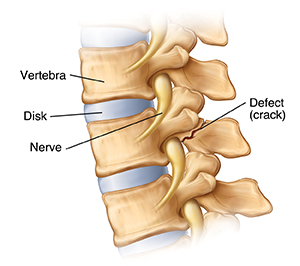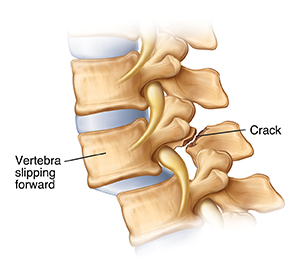When Your Child Has Spondylolysis or Spondylolisthesis
You've been told your child has a problem with their vertebrae. These are the bones that stack together to make up the spine. Spondylolysis is a crack (defect) in the back part of a vertebra. Spondylolisthesis is the slipping forward of a vertebra. Spondylolisthesis is often due to spondylolysis. But a child can have one without the other. If your child has this spine problem, they may see a spine specialist (a healthcare provider who treats back and spine problems).
What are the causes of spondylolysis and spondylolisthesis?
One common cause of these problems is repeated extension of the spine (bending backward). Children who do activities that need spine extension (such as gymnastics, diving, and dance) are more likely to get these problems than other children. Other activities that may increase a child’s risk include weightlifting. Some ball sports, such as football and soccer, may also make the problems more likely.
What are the signs and symptoms of spondylolysis or spondylolisthesis?
These problems almost always happen in the low back. A child can have either problem and have no symptoms. Or, they can have back soreness, back pain, or muscle spasms in the back. The pain can sometimes travel into the thighs and buttocks.
How are spondylolysis and spondylolisthesis diagnosed?
The healthcare provider will ask about the child’s activities and medical history. An X-ray (test that creates images of bones) is usually the only test that is needed. The problem often can be seen on an X-ray. In certain cases, other imaging tests (such as an MRI or a CT scan) may be done to get more detailed information about your child’s spine.
How are spondylolysis and spondylolisthesis treated?
These problems can’t be cured, but they often stop causing problems in time. In the meantime, your child’s symptoms can be treated.
Medicines. To help reduce back pain and swelling, medicines may be prescribed. These are usually NSAIDs (nonsteroidal anti-inflammatory drugs). These medicines include ibuprofen and naproxen. They may be over-the-counter or prescription. The healthcare provider will tell you what types and dosage are best for your child. Give these medicines to your child only as prescribed.
Physical therapy. Stretching and strengthening the muscles around the spine and in the legs can help ease symptoms due to these conditions. The provider may refer your child to a physical therapist (PT) for a course of physical therapy and exercises.
Resting the back. This means stopping any activity that stresses the back. Once your child stops having symptoms, they can often go back to a normal activity level. If a child continues to have symptoms, a small reduction in activity may help.
Bracing. Your child may be fitted with a brace to wear for a few weeks to months. The brace takes stress off the spine. This allows symptoms to resolve.
Surgery. If spondylolisthesis is severe or can’t be treated with nonsurgical means, surgery may be done. During surgery, the slipping vertebra is fused to the vertebra below it. This is to prevent further movement.
What are the long-term concerns?
When the back pain is caused by a pulled muscle, a strained ligament, or bruising, symptoms usually go away within 1 week without special treatment. Once symptoms have been treated, spondylolysis and spondylolisthesis rarely cause further problems. But a child with these conditions should be checked regularly by the healthcare provider as they grow. This is to be sure more problems don’t develop.

